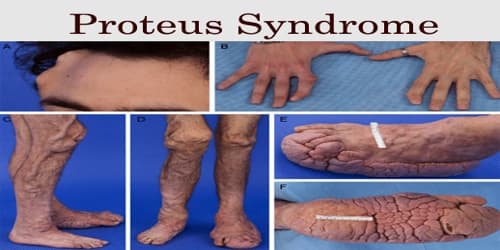
Proteus Syndrome
Proteus syndrome is an extremely rare genetic condition that causes tissues of the body, such as skin and bone, to overgrow. The overgrowth often happens disproportionately, and can severely change a person's appearance. The syndrome takes its name from Proteus, in Greek mythology, the prophetic old man of the sea who could change his shape at will. As a child, Watson experienced developmental delays. The youngest of his parents’ three biological children, he was weaker than the others and late in meeting his developmental milestones.
Table 1: Classification of Macrodactyly with Associated Conditions Subtype Associated Distinguishing Conditions Features True Proteus syndrome Connective tissue nevi, Macrodactyly epidermal nevi, disproportionate growth False Ollier's disease Enchondromatosis, Macrodactyly cerebral tumours Maffucci's syndrome Enchondromatosis, haemangioma Milroy's disease Congenital lymphedema Klippel-Trenaunay Port wine haemangioma, syndrome varicose veins, soft tissue/bone hypertrophy Vascular malformati on Neurofibro matosis Table 2: Review of Literature of Macrodactyly Sl.
Proteus syndrome is a rare condition characterized by overgrowth of the bones, skin, and other tissues. Organs and tissues affected by the disease grow out of proportion to the rest of the body.
Although the likelihood of data leak to external parties was assessed to be low, the 98,000 MINDEF/SAF personnel were informed from 21 December 2019.Both incidents were confined to the systems of the vendors, and did not affect MINDEF’s own systems or result in the loss of classified military information, said Dr Ng Eng Hen.He added that “MINDEF takes a serious view of these cases. With the help of a cybersecurity firm, HMI investigated the infection and ascertained the individuals from MINDEF/SAF and other organisations whose personal data were on the affected backup server. Trojan horse virus incidents.
The overgrowth is usually asymmetric, which means it affects the right and left sides of the body differently. Newborns with Proteus syndrome have few or no signs of the condition. Overgrowth becomes apparent between the ages of 6 and 18 months and gets more severe with age.In people with Proteus syndrome, the pattern of overgrowth varies greatly but can affect almost any part of the body. Bones in the limbs, skull, and spine are often affected. The condition can also cause a variety of skin growths, particularly a thick, raised, and deeply grooved lesion known as a cerebriform connective tissue nevus. This type of skin growth usually occurs on the soles of the feet and is hardly ever seen in conditions other than Proteus syndrome.
Blood vessels (vascular tissue) and fat (adipose tissue) can also grow abnormally in Proteus syndrome.Some people with Proteus syndrome have neurological abnormalities, including intellectual disability, seizures, and vision loss. Affected individuals may also have distinctive facial features such as a, outside corners of the eyes that point downward , a with wide nostrils, and an open-mouth expression. For reasons that are unclear, affected people with neurological symptoms are more likely to have distinctive facial features than those without neurological symptoms. It is unclear how these signs and symptoms are related to abnormal growth.Other potential complications of Proteus syndrome include an increased risk of developing various types of noncancerous (benign) tumors and a type of blood clot called a.
DVTs occur most often in the deep veins of the legs or arms. If these clots travel through the bloodstream, they can lodge in the lungs and cause a life-threatening complication called a. Solitaire castle cheats. Pulmonary embolism is a common cause of death in people with Proteus syndrome. Proteus syndrome is a rare condition with an incidence of less than 1 in 1 million people worldwide. Only a few hundred affected individuals have been reported in the medical literature.Researchers believe that Proteus syndrome may be overdiagnosed, as some individuals with other conditions featuring asymmetric overgrowth have been mistakenly diagnosed with Proteus syndrome. To make an accurate diagnosis, most doctors and researchers now follow a set of strict guidelines that define the signs and symptoms of Proteus syndrome.
Proteus syndrome results from a mutation in the gene. This genetic change is not inherited from a parent; it during the early stages of development before birth.
As cells continue to grow and divide, some cells will have the mutation and other cells will not. This mixture of cells with and without a genetic mutation is known as.The AKT1 gene helps regulate cell growth and (proliferation) and cell death. A mutation in this gene disrupts a cell's ability to regulate its own growth, allowing it to grow and divide abnormally. Increased cell proliferation in various tissues and organs leads to the abnormal growth characteristic of Proteus syndrome.
Studies suggest that an AKT1 gene mutation is more common in groups of cells that experience overgrowth than in the parts of the body that grow normally.In some published case reports, mutations in a gene called have been associated with Proteus syndrome. However, many researchers now believe that individuals with PTEN gene mutations and asymmetric overgrowth do not meet the strict guidelines for a diagnosis of Proteus syndrome. Instead, these individuals actually have condition that is considered part of a larger group of disorders called PTEN hamartoma tumor syndrome. One name that has been proposed for the condition is segmental overgrowth, lipomatosis, arteriovenous malformations, and epidermal nevus (SOLAMEN) syndrome; another is type 2 segmental Cowden syndrome. However, some scientific articles still refer to PTEN-related Proteus syndrome.
Lindhurst MJ, Sapp JC, Teer JK, Johnston JJ, Finn EM, Peters K, Turner J, Cannons JL, Bick D, Blakemore L, Blumhorst C, Brockmann K, Calder P, Cherman N, Deardorff MA, Everman DB, Golas G, Greenstein RM, Kato BM, Keppler-Noreuil KM, Kuznetsov SA, Miyamoto RT, Newman K, Ng D, O'Brien K, Rothenberg S, Schwartzentruber DJ, Singhal V, Tirabosco R, Upton J, Wientroub S, Zackai EH, Hoag K, Whitewood-Neal T, Robey PG, Schwartzberg PL, Darling TN, Tosi LL, Mullikin JC, Biesecker LG. A mosaic activating mutation in AKT1 associated with the Proteus syndrome. N Engl J Med. 2011 Aug 18;365(7):611-9. Doi: 10.1056/NEJMoa1104017. Epub 2011 Jul 27.